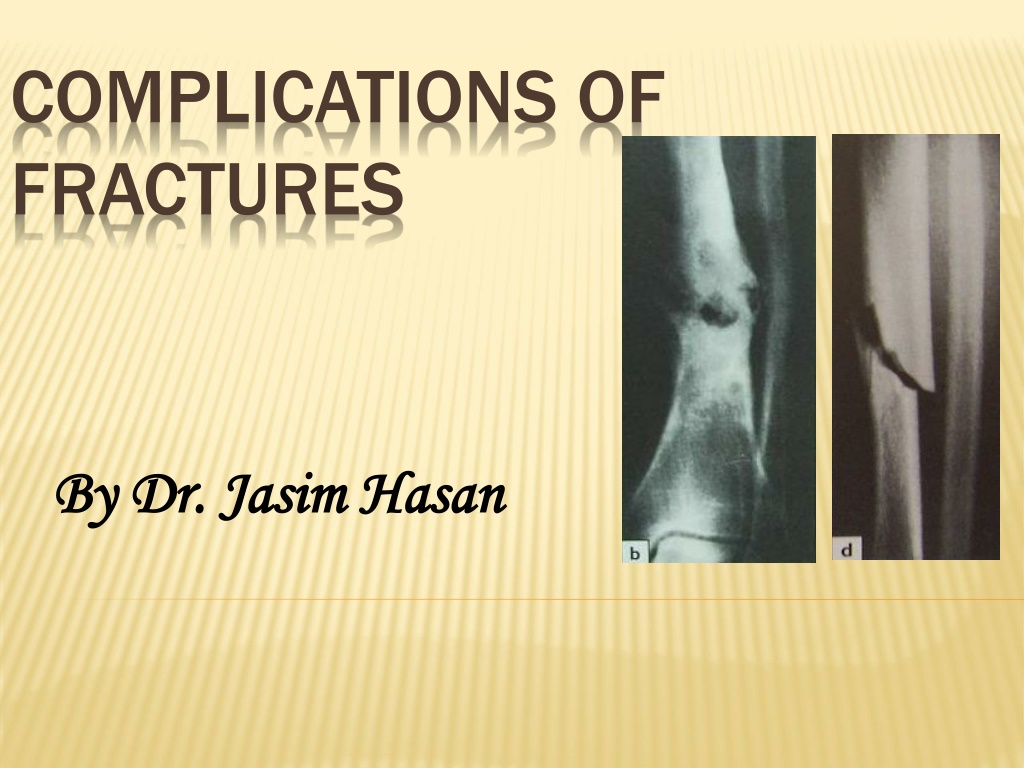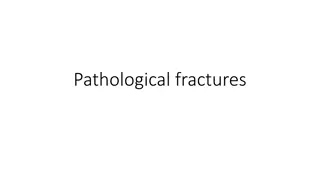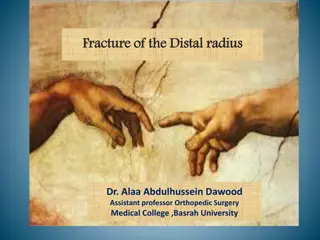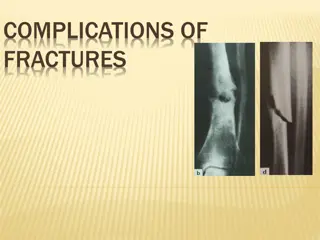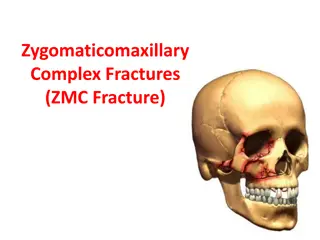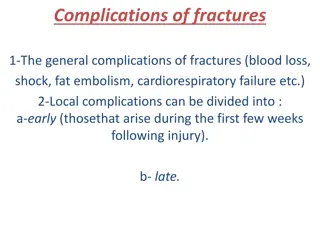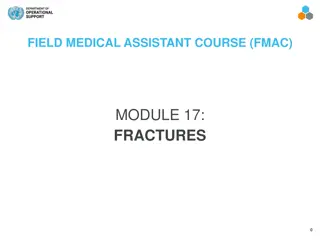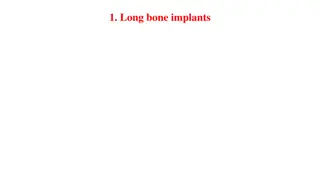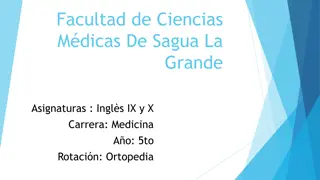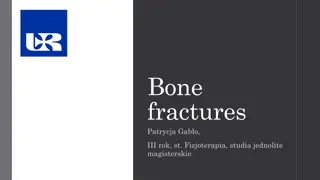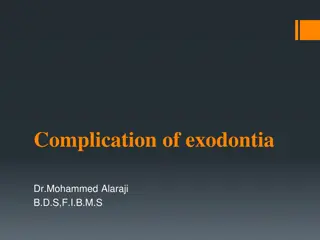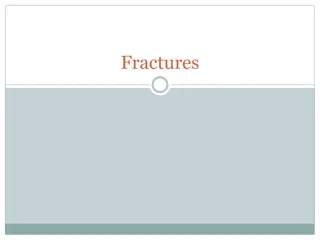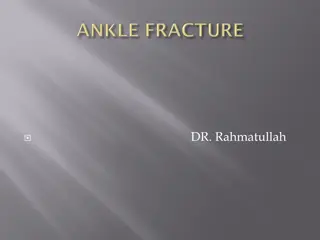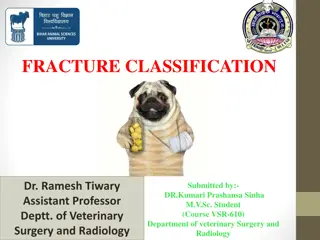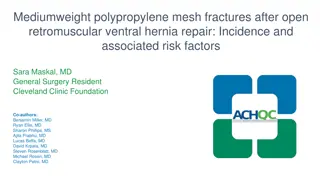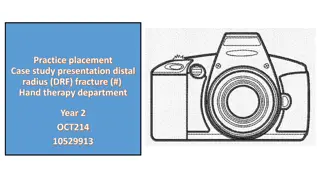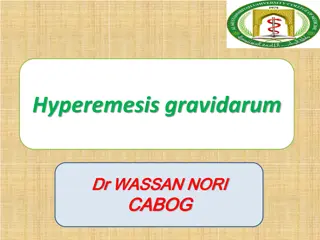Complications of Fractures and Their Management by Dr. Jasim Hasan
This detailed presentation by Dr. Jasim Hasan covers the complications of fractures, including general and local complications, early and late complications, and specific issues such as shock, vascular injuries, nerve damage, and more. The information highlights the importance of recognizing and addressing these potential complications to ensure optimal healing and recovery for patients with fractures.
Download Presentation

Please find below an Image/Link to download the presentation.
The content on the website is provided AS IS for your information and personal use only. It may not be sold, licensed, or shared on other websites without obtaining consent from the author. Download presentation by click this link. If you encounter any issues during the download, it is possible that the publisher has removed the file from their server.
E N D
Presentation Transcript
COMPLICATIONS OF FRACTURES By Dr. Jasim Hasan By Dr. Jasim Hasan
COMPLICATION OF FRACTURE General Local Early Late
General complications Shock Hypovolemic or hemorrhagic shock. Septic shock. Neurogenic shock. Fat embolism. Pulmonary embolism. Crush syndrome. Multiple organs failure syndrome (MOFS). Thrombo-embolism. Tetanus. Gas gangrene.
Local complications Early 1. Visceral injury (the lung, the bladder, the urethra, and the rectum). 2. Vascular injury. 3. Nerve injury. 4. Compartment syndrome. 5. Haemoarthrosis. 6. Infection. 7. Gas gangrene. 8. Fracture blisters. 9. Plaster and pressure sores. 10. Tendon injury.
Late 1. Delayed union. 2. Non-union. 3. Malunion. 4. Avascular necrosis. 5. Growth disturbance. 6. Bed sore. 7. Myositis ossificans. 8. Muscle contracture. 9. Tendon lesions. 10.Nerve compression and entrapment. 11.Joint instability. 12.Joint stiffness. 13.Complex regional pain syndrome. ( algodystrophy). 14.Osteoarthritis.
EARLY COMPLICATION Local Visceral Injury Vascular Injury Nerve Injury Compartment Syndrome Haemarthrosis Infection Gas gangrene
LOCAL VISCERAL INJURY Fracture around the trunk are often Cx by injury to the adjacent viscera : Bladder and urethral rupture Pelvic fracture Rib fracture penetration to the lungs Pneumothorax
VASCULAR INJURY Most commonly knee, femoral shaft, elbow, and humerus. Artery may be cut, torn, compressed or contused. Intima may be detached, thrombus block, artery spasm Effect ?? bld flow coz Ischemia leads to tissue death & peripheral gangrene
Common vascular injuries may associate with the following fractures. 1.First rib or clavicle fracture (subclavian artery). 2.Shoulder dislocation (Axillary artery). 3.Humeral supracondylar fracture (brachial artery). 4.Elbow dislocation (Brachial artery). 5. Pelvic fracture (presacral and internal iliac). 6. Femoral supracondylar fracture (Femoral artery). 7. Knee dislocation (Popliteal artery). 8. Proximal tibia (popliteal or its branches).
CLINICAL FEATURES Pt with ischemia may have 5 P s: - paraesthesia/numbness - pain - pallor - pulselessness - paralysis Investigate if suspect vascular injury : Angiogram
TREATMENT Emergency treatment All bandages/splints removed The fracture X-Ray again Circulation reassessed for next half hour If no improvement, do vessels exploration Suture torn vessels, vein grafting, if thrombosed do endarterectomy Aim: to restore bld flow
NERVE INJURY Variable degree of motor and sensory loss along the distribution of the nerve May be neurapraxia, axonotmesis or neurotmesis Radial nerve is most frequently damaged nerves.
Nerve Trauma Effect Axillary Dislocation of shoulder # of humerus Deltoid paralysis Radial Wrist drop Median Supracondylar # of humerus # medial epicondyl humerus Post dislocation of hip Pointing index Ulnar Claw hand Sciatic Foot drop Common peroneal Knee dislocation # neck of fibula Foot drop
In closed injuries nerve is seldom severed and spontaneous recovery should be awaited. In open fractures complete lesion(neurotmesis) : the nerve is explored during wound debridement and repaired.
COMPARTMENT SYNDROME Definition Definition Compartment syndrome involves the compression of nerves and blood vessels within an enclosed space, leading to impaired blood flow and nerve damage. Fascia separate groups of muscles in the arms and legs from each other. Inside each layer of fascia is a confined space, called a compartment, that includes the muscle tissue, nerves, bones and blood vessels. A rise in pressure within these compartments may jeopardize the blood supply to the muscles & nerves within the compartment.
Causes: muscle muscle -any injury/infection leading to edema of -fracture haematoma within the compartment -ischemia to the compartment leading to oedema -Due to tight bandages or casts Hallmark Symptoms: - severe pain that does not respond to elevation or pain medication. - In more advanced cases, there may be decreased sensation, weakness, and paleness of the skin.
Injuries with a high risk of developing Compartments synd: # of the elbow # of the forearm bone # of the proximal third of the tibia
THE VICIOUS CYCLE OF VOLKMANN S ISCHAEMIA 5P s Pain Pallor Paraesthesia Pulseless Paralysis Arterial ischaemia blood flow Damage ..... . . Fasciotomy Direct injury oedema Compartment pressure
A vicious cycle cont. until the total vascularity of the muscles and nerves is jeopardized. This result in ischaemic muscle necrosis and nerve damage. (within 12 hours) The necrotic muscle undergo healing with fibrosis, leading to Volkmann s contracture. Nerve damage may result in motor and sensory loss. In extreme case gangrene
clinically: Early preventing : limb elevation Dx : confirmed by direct intracompartmental pressure measuring > 40mmHg is an indication of compartment decompression and fasciotomy. - should be tested by stretching the muscles when the toes or fingers are passively hyperextended there is pain in the calf or forearm.
Treatment Treatment First removed all the bandages & dressing. Fasciotomy is performed. The wound should be left open and inspected 2 days later. If there is muscle necrosis debridement If muscle is healthy suture (w/o tension)/ skin grafted / simply heal by 2 intention.
HAEMARTHROSIS Fractures involve joints, leads to acc. of blood within the joints. C/Feature :The joint is swollen and tense and patient will resists any movement. Tx : the blood should be aspirated before dealing with the fracture.
INFECTION Causes: Open fracture (common) Use of operative method in the Tx of # # Wound becomes inflamed and starts draining seropurulent fluid. Infection may be superficial, moderate (osteomyelitis), severe (gas gangrene). Post-traumatic wound infx is most common cause of chronic osteomyelitis union will be slow and chance of refracturing.
Treatment: Antibiotic Excising all devitalised tissue If Sx of acute infx and pus formation : tissue around the fracture should be opened & drained
GAS GANGRENE Produced by anaerobic orgs : Clostridium sp infections. These orgs can survive in O2 tension Toxins produced will destroy the cell wall and leads to tissue necrosis C/feature: within 24hr. Pt complains: - intense pain - swelling around the wound - brownish discharge - gas formation - pyrexia - characteristic smelling - PR - toxaemic coma death Inability to recognize may lead to unnecessary amputation for the non-lethal cellulitis.
swelling around the wound, brownish discharge gas formation
Prevention: Prevention: deep penetrating wound in muscular tissue are dangerous;should be explored, all dead tissue should be completely excised, and if there doubt about the tissue viability should left open the wound Treatment: Treatment: Early Dx is life saving General measures: Fluid replacement & IV Antibiotic (immediate) Hyperbaric O2 (limiting the spread of gangrene) Mainstay : prompt decompression & remove dead tissue
Thank You Thank You
